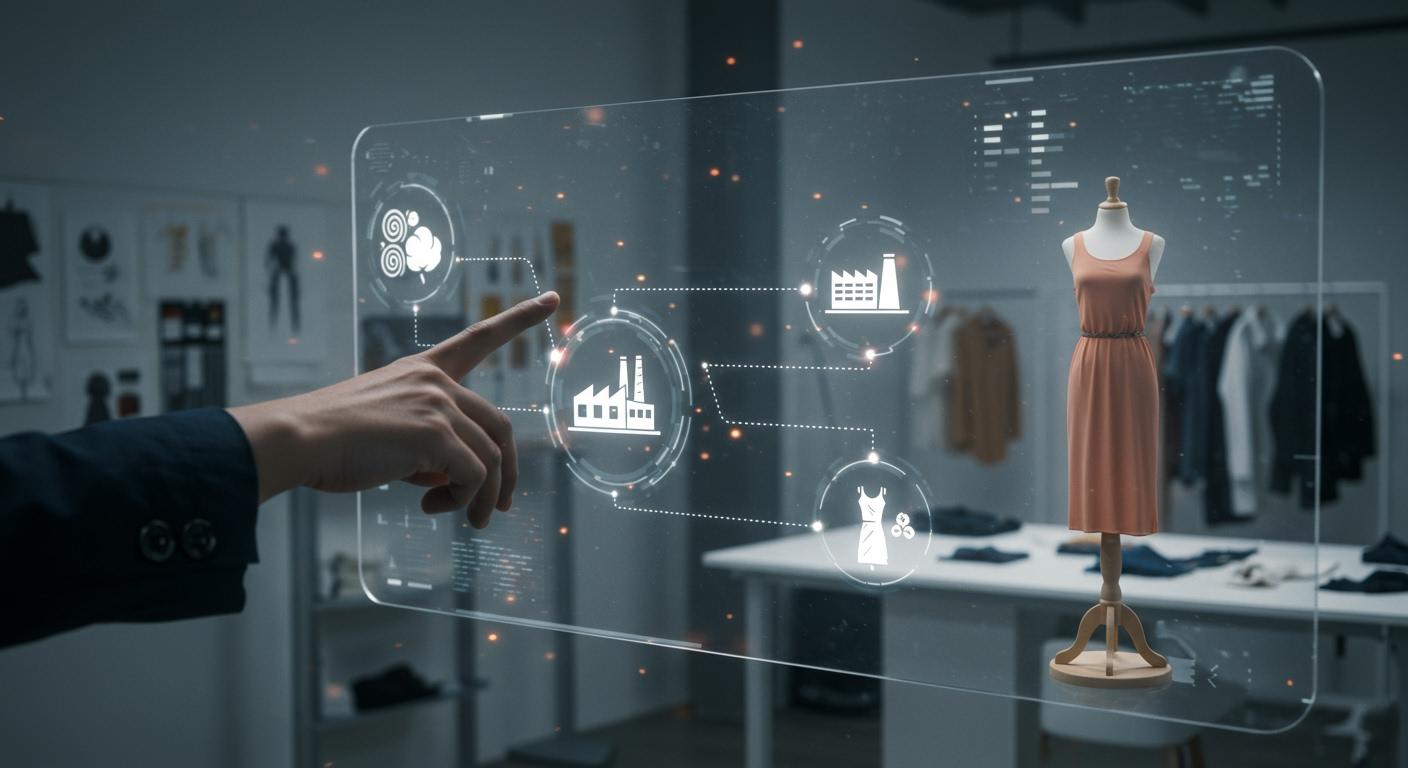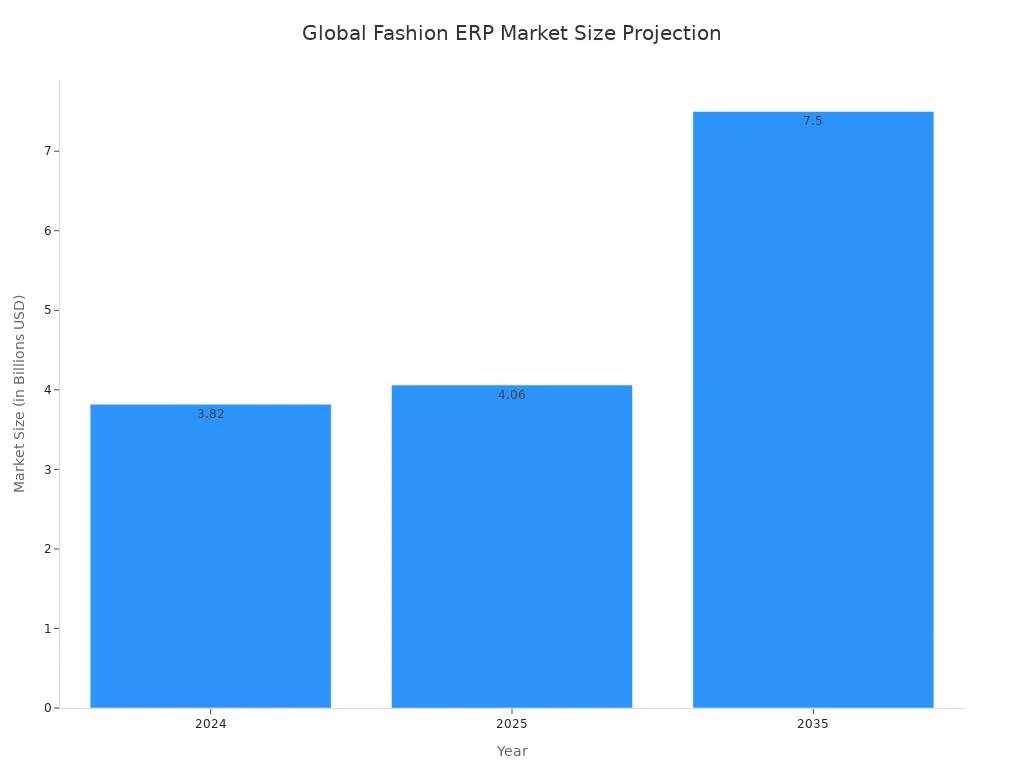
The modern fashion industry demands a digital transformation in fashion. Top ERP solutions for 2025—including NetSuite, Aptean, and Infor CloudSuite Fashion—drive this change. This advanced supply chain management software provides a single source of truth. It enables real-time tracking and seamless integration for fashion brands.
Only 13% of businesses report full supply chain visibility. A lack of real-time tracking exposes brands to significant risk.
This ERP software is essential for the fashion industry. The right software gives brands the real-time visibility needed to compete. The market for fashion ERP software continues its rapid expansion.

This guide helps fashion brands solve these critical fashion challenges. It shows how the correct ERP software can build a more resilient fashion business.
Top ERP Solutions for 2025
Choosing the right ERP software is a critical decision for any brand in the fashion industry. The leading ERP solutions for 2025 offer specialized features that address the unique challenges of the apparel industry. These systems provide the visibility needed to thrive in a fast-paced market.
Unified Commerce and Inventory
Modern fashion brands operate across multiple channels. They need a single, accurate view of their inventory. NetSuite stands out as a premier choice for unified commerce. It is recognized as a leading ERP software for fashion organizations, transforming businesses worldwide. The software gives sales associates a complete view of inventory and customer data. This empowers them to enhance the buyer's journey. Shoppers can buy and return items anywhere, creating a true omnichannel experience.
NetSuite's platform provides a single source of truth. It achieves this through several key integrations:
- Point of Sale (POS): Gives a 360-degree omnichannel view of inventory and customer information.
- RFID Integration: Uses Radio Frequency Identification for asset logging and cycle counts.
- 3PL Logistics Integration: Manages procurement and fulfillment for better delivery tracking and lower shipping costs.
This seamless integration allows for real-time inventory tracking. Brands can prevent stockouts and avoid overselling. The software automates many inventory management processes.
| Feature | Description | Benefits |
|---|---|---|
| Integrated Inventory Tracking | Tracks stock levels and movement across all channels. | Minimizes stockouts and ensures accurate inventory management. |
| Automated Reordering | Generates purchase orders when stock hits a set level. | Prevents stockouts and ensures a consistent product supply. |
| Real-Time Inventory Sync | Updates inventory levels instantly as sales happen. | Avoids overselling and shows accurate stock to customers. |
Luxury brand Frescobol Carioca achieved 99% picking accuracy after implementing NetSuite. This real-time system automated its warehouse operations and eliminated manual errors, showcasing the power of unified ERP software.
End-to-End Production Management
The fashion supply chain is complex. It involves designers, suppliers, and manufacturers across the globe. Aptean BlueCherry is an ERP software designed specifically for the fashion and apparel industry. It provides end-to-end visibility from concept to consumer. This software helps manage production timelines effectively. It also ensures ethical sourcing and compliance.
Aptean improves supply chain management by connecting Product Lifecycle Management (PLM) with supplier data. This connection offers a clear view of the entire production process. Key benefits include:
- Improved Timelines: Brands gain better control over production schedules.
- Ethical Sourcing: The software helps track supplier compliance with labor and environmental standards.
- Cost Control: Detailed tracking of materials and labor helps manage costs effectively.
This level of control is essential in today's fashion industry. Consumers demand transparency. Regulators require strict compliance. Aptean provides the tools to meet these demands.
AI-Powered Demand Analytics
Predicting trends is crucial for success in fashion. Infor CloudSuite Fashion uses artificial intelligence to give brands a competitive edge. This advanced ERP software analyzes data to forecast trends and personalize customer experiences. AI-powered demand forecasting helps brands anticipate market shifts. This allows for smarter inventory decisions, reducing both stockouts and overstock.
The AI within Infor's software transforms supply chain management. It delivers complete transparency and optimizes inventory levels. Businesses using this technology report significant gains.
Did you know? 💡 A recent study showed that 100% of Infor users saw measurable improvements within months of implementation. Additionally, 78% reported improved supply chain resilience and agility.
Infor's AI capabilities enable fashion brands to:
- Make informed decisions with greater accuracy.
- Optimize inventory for dynamic markets.
- Support new revenue streams and business models.
By leveraging AI, these ERP solutions help fashion companies stay ahead of trends. They build more efficient operations and improve customer satisfaction. The right ERP software makes the entire fashion business more agile and profitable.
Core Features for End-to-End Supply Chain Visibility

Achieving end-to-end supply chain visibility requires a specific set of tools. The best ERP software for the fashion industry provides core features that connect disparate parts of the business. These capabilities transform raw data into actionable intelligence, giving brands a decisive competitive advantage. From materials sourcing to final sale, these features create a single, transparent operational view.
Real-Time Inventory Tracking
Effective supply chain management begins with knowing what you have and where it is. Real-time inventory tracking is a foundational feature of modern ERP software. It eliminates guesswork and provides an accurate, live picture of stock levels across all channels. This capability is essential for the fast-moving apparel industry.
Advanced ERP software offers granular tracking functionalities. These systems provide brands with the tools for precise control.
- SKU Management: The software offers real-time tracking of Stock Keeping Units (SKUs) with detailed size and color matrices.
- Automated Alerts: It sends low stock alerts and automates reordering processes to prevent stockouts.
- High-Value Tracking: Serialized inventory tracking is available for high-value fashion items, adding a layer of security.
- Location Management: The software manages inventory across multiple locations, including warehouses, retail stores, and third-party logistics (3PL) providers.
This level of real-time visibility helps brands improve fulfillment, reduce carrying costs, and increase customer satisfaction.
Supplier and PLM Integration
The journey of a fashion product from concept to consumer is complex. A seamless integration between Product Lifecycle Management (PLM) and ERP systems creates a cohesive workflow. PLM software enhances design and development, while the ERP optimizes supply chain management, inventory, and financials. This combination reduces errors and boosts efficiency.
A centralized supplier portal is a key component of this integration. It acts as a single hub for all vendor communication and management.
- Centralized Communication: Vendors can access purchase orders, update shipment information, and communicate directly through the portal.
- Performance Tracking: The software provides a complete view of vendor activities, including performance metrics and contract management.
- Quality Control: It includes tools to set quality standards, monitor compliance, and record inspection results at different stages of the fashion supply chain.
- Cost Management: The system offers detailed insights into vendor pricing and payment terms, helping brands negotiate better terms and control costs.
AI-Driven Demand Forecasting
The fashion industry loses an estimated $163 billion annually due to overproduction and excess inventory. AI-powered demand forecasting directly addresses this challenge. This advanced software analyzes historical sales data, market trends, and consumer behavior to predict future demand with remarkable accuracy. This allows for smarter inventory management in the apparel industry.
AI platforms deliver measurable results. They help fashion brands align production with actual market needs, significantly reducing waste and improving profitability.
| AI Platform | Impact on Inventory and Accuracy |
|---|---|
| Stylumia | Reduces excess inventory by up to 40% |
| Syrup Tech | Lowers overall inventory levels by up to 30% |
| WAIR's ForecastGPT-2.5 | Achieves 96-97% accuracy in SKU-level demand forecasting |
By using AI, fashion companies can make data-driven decisions, minimize overstock, and ensure popular items are always available.
Omnichannel Data Unification
Today's consumers shop across e-commerce sites, physical stores, and social media. Unifying data from these channels is a major challenge. A Gartner study found that 72% of retailers lose revenue from inconsistent product data. Disconnected systems create inventory blind spots and logistical hurdles, threatening brand consistency.
An ERP software with omnichannel capabilities solves this problem. It creates a single, unified customer profile by combining data from all touchpoints. This holistic view powers true personalization.
A unified data view deepens customer intelligence. It combines operational data like transaction histories with behavioral data. This allows for improved cross-channel personalization, faster sales cycles, and predictive customer service.
This unified approach enables fashion brands to:
- Create targeted marketing campaigns based on purchase history.
- Offer personalized product recommendations and discounts.
- Provide customer service teams with a complete interaction history for more informed support.
This real-time data synchronization ensures a seamless and consistent customer experience at every touchpoint.
Sustainability and Compliance
Consumers and regulators increasingly demand transparency in the fashion industry. Modern ERP software provides the tools necessary to manage sustainability goals and ensure compliance. These platforms help brands collect, standardize, and analyze supplier data for audits and reporting. The software makes tracking key metrics easier.
To make data useful, brands must embed ESG KPIs directly into enterprise resource planning (ERP) systems. Stella McCartney integrated ESG metrics into financial forecasting and supply chain decisions. This grounds sustainability goals in business areas like inventory management and procurement.
This software helps with tracking environmental impact by monitoring energy usage, water consumption, and waste generation. By integrating compliance management into core operations, a fashion brand can build trust, mitigate risk, and create a more responsible business model.
Selecting the Right ERP for Your Fashion Supply Chain

Choosing the right ERP software is a critical step in a brand's digital transformation. The best ERP solutions align with a company's specific needs. This selection process ensures the software provides a true return on investment for any fashion business.
Assess Your Visibility Gaps
A brand must first identify its weaknesses. Many fashion companies struggle with data overload and a lack of visibility beyond their main suppliers. A thorough audit of the fashion supply chain reveals these gaps. Methods for this audit include:
- Mapping all raw material sources.
- Using supplier performance dashboards to track metrics.
- Linking purchase orders and shipment records in one system.
This assessment helps a fashion brand pinpoint where it needs the most improvement. This is the first step in its software transformation.
Match Features to Business Scale
The needs of a fashion brand depend on its business model. A direct-to-consumer (D2C) brand focuses on customer experience, while a wholesale business prioritizes operational efficiency. The right ERP software supports these different goals.
| Business Model | Key ERP Software Focus |
|---|---|
| Direct-to-Consumer (D2C) | Omni-channel consistency, customer experience |
| Wholesale / Production-Driven | B2B sales, EDI, operational efficiency |
Cloud-based ERP solutions offer adaptable infrastructure. This software scales with a growing fashion business, providing a cost-effective path for growth in the competitive fashion industry.
Evaluate ERP Software Integration
Modern ERP software must connect with other critical systems. A fashion brand needs seamless integration with platforms for Product Lifecycle Management (PLM), third-party logistics (3PL), and accounting. Poor integration creates significant risks. It can lead to data misalignment, requiring staff to spend hours on manual reconciliation. This undermines the purpose of the software investment. Evaluating how the software connects with existing tools is essential.
Request Targeted Demonstrations
Brands should request demonstrations that reflect their daily operations. This is the best way to verify a software's capabilities. Ask vendors to show specific scenarios, such as:
- Managing sales and customer data across all channels in real-time.
- Tracking sustainability and compliance metrics.
- Handling the entire production workflow from order to delivery.
A targeted demo confirms the ERP software can solve the unique challenges of the apparel industry and the broader fashion industry. It ensures the chosen real-time ERP solutions will deliver results.
Success in the 2025 fashion market depends on achieving total supply chain visibility. An integrated fashion ERP delivers this crucial fashion advantage. The right fashion system connects fashion design, fashion production, and fashion sales data into a single, actionable view. This unified perspective covers the entire fashion supply chain. Choose the ERP solution that best resolves your visibility gaps to build a more resilient and profitable fashion brand.
FAQ
What is a fashion ERP?
A fashion ERP is specialized software. It helps a fashion brand manage its entire operation. The system integrates processes like design, manufacturing, inventory, and sales. It provides a single, unified view of the business.
How does an ERP improve supply chain visibility?
An ERP system connects all operational data into one place. It offers real-time tracking from production to the final customer. This gives a fashion brand a clear, end-to-end view, eliminating blind spots and improving decision-making.
How long does it take to implement a fashion ERP?
Implementation time varies based on a company's size and complexity. A project can take anywhere from a few months to over a year. Key factors include:
- Data migration needs
- System customization
- Employee training
Can small fashion brands use ERP software?
Yes. Many vendors offer scalable, cloud-based ERP solutions. These systems provide powerful tools without a large initial investment. They help small brands grow efficiently and compete in the fast-paced fashion market.
See Also
Revolutionizing Fashion Retail with Dynamic AI Safety Stock Solutions by 2025
Eco-Conscious Fashion: AI Solutions for a Sustainable and Better Planet
Transformative Impact of AI Sensors on the 2025 Fashion Supply Chain
Achieve Precise Fashion Forecasts Utilizing Comprehensive Sales Data Insights
Intelligent AI Solutions: Streamlining Fashion Returns for Immediate Efficiency